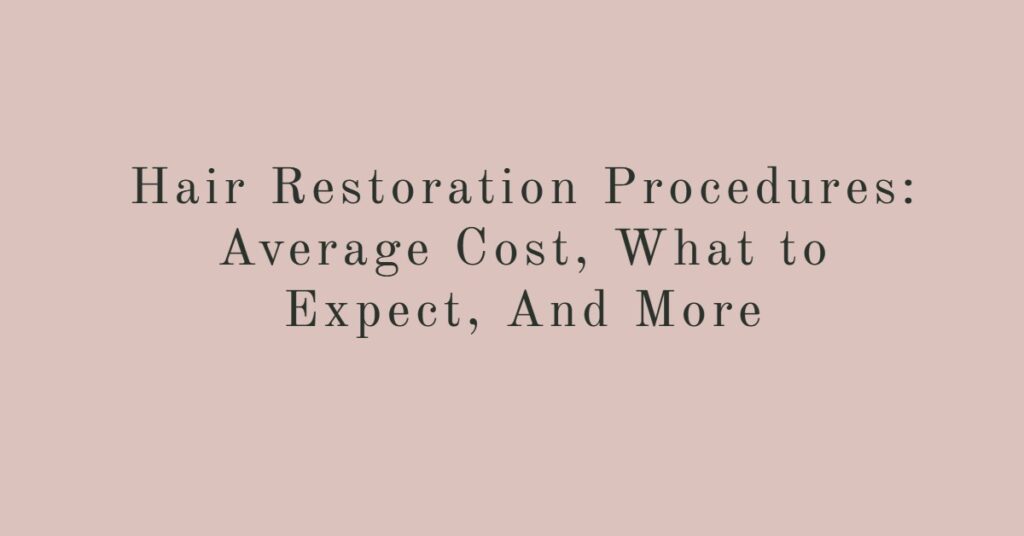Why would anyone consider ahair restoration procedure? Doesn’t it involve surgery or other invasive procedures? First, there are several reasons why people go through hair baldness, such as genetic, medical problems, or lack of proper precautions when treating hair. But the effects of any of these can damage someone’s self-esteem.
Common Conditions That Make Ideal Hair Restoration Treatment
- Alopecia areata- It’s a hair loss problem that happens when the immune system attacks the hair follicles due to severe stress.
- Androgenic alopecia, or pattern baldness.
- Hormonal imbalances
- Burns or traumatic injuries.
Most People with permanent baldness caused by genetics are usually the best candidates for hair transplant.?

Hair Restoration
A person can get hair restoration through hair loss medications such as minoxidil, which you can buy with its brand name known as Rogaine. However, this only works temporarily. So, if you need a permanent solution, a hair transplant can be your ideal hair loss solution.
When you consider a hair transplant, you’ll have two options that your doctor will talk to you about and advise accordingly. We shall look at these two, so you know what to expect.
Your surgeon will put the patient under a local anesthetic to prevent any pain or discomfort as you’ll be awake during these procedures.
Follicular Unit Transplantation (FUT)
So, when you choose to go for FUT, hair restoration surgery, this is what to expect:
A surgeon will extract a thin strip of skin from the donor area, which is usually at the back of the head. After that, he will stitch the donor site where he removed the grafts. And then, he will divide them with his team into pieces of 1 to 4 hairs grafts. Now, these will be ready for placing into the recipient area.
Unfortunately, this procedure may leave a linear scar on your head, unlike the FUE. But this should not be a problem if you keep long hair. However, this scar can be visible for those who keep short hair.
Follicular Unit Extraction (FUE):
In FUE hair restoration treatment, the process takes just a day. And your surgeon will start the following procedure:
He shaves the head to easily the donor area. Then he will remove the individual hairs per graft and transplant them on the tiny cuts targeted.
After the procedure, you will only have a few dot-like scars that are hardly noticeable.
Depending on the region requiring the treatment, this will determine the number of treatments. For example, if a patient has a larger area, he may need two or more sessions. But this takes place a few months apart.
Side Effects Expected From Hair Restoration
Some of the common adverse reactions you might experience include the following:
- Aches
- Itching
- The treated site may get swollen for a few days
- Scabbing may occur in the recipient area.
- A linear scar from the FUT procedure.
- Allergic reaction from the anesthetic application.
Other possible problems include bleeding, infection, or hair transplant doesn’t work, which is rare.
When you experience severe pain or such symptoms that are not expected, you should not hesitate to contact your surgeon.
Recovery
Most people are usually ready to go back to work after three days of hair restoration transplant. Since the grafts are still fresh and delicate after two weeks, you must take precautions. And these include:
- Cutting down on strenuous exercise in the first month to help reduce scarring.
- Avoid touching grafts from 2-5 days after removing the bandages.
- Thenyou should wait after six days to wash your hair gently.
- You should have any non-dissolvable stitches removed after 10 to 14 days by your doctor.
- A few weeks after your procedure, your transplanted hair will start falling out as a normal healing process. But it should stop after several weeks, and new hair will start growing after six months. Then after 12-18 months, that’s when you’re likely to see full results.
Hair Restoration Cost
A hair transplant can cost anywhere from $4,000 to $15,000, But the actual cost will depend on a patient’s hair loss. Other factors that will also contribute include type of procedure, surgeon’s experience, quality of the clinic, and the team involved.
Conclusion
When you’re considering?hair restoration, it’s best to look for a professional and experienced hair transplant surgeon. It’s a sensitive procedure, and one would want to have the best results. You will later enjoy this procedure’s full benefits, including a fuller head of hair and improved self-esteem. And this gives you a permanent hair loss solution you’ve always wanted.?
Author Bio:
Naman Modi is a Professional Blogger, SEO Expert & Guest blogger at?beverlyhillshr.com.?He is an Award-Winning Freelancer & Web Entrepreneur helping new entrepreneurs launch their first successful online business.

As the editor of the blog, She curate insightful content that sparks curiosity and fosters learning. With a passion for storytelling and a keen eye for detail, she strive to bring diverse perspectives and engaging narratives to readers, ensuring every piece informs, inspires, and enriches.









